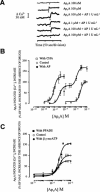Modulation of the dinucleotide receptor present in rat midbrain synaptosomes by adenosine and ATP
- PMID: 10807683
- PMCID: PMC1572065
- DOI: 10.1038/sj.bjp.0703300
Modulation of the dinucleotide receptor present in rat midbrain synaptosomes by adenosine and ATP
Abstract
Diadenosine polyphosphates activate dinucleotide receptors in rat midbrain synaptic terminals. The agonist with highest affinity at this receptor, diadenosine pentaphosphate (Ap(5)A), elicits Ca(2+) transients at concentrations ranging from 10(-7) to 10(-3) M with a single-phase curve and an EC(50) value of 56.21+/-1.82 microM. Treatment of synaptosomal preparations with alkaline phosphatase (AP) changes the dose-response control curve into a biphasic one presenting two EC(50) values of 6.47+/-1.25 nM and 11.16+/-0.83 microM respectively. The adenosine A(1) antagonist 8-cyclopentyl-1, 3-dipropylxanthine (DPCPX) reversed the biphasic concentration-response for Ap(5)A curve in the presence of AP, to a monophasic one with an EC(50) value of 76.05+/-7.51 microM. The application of adenosine deaminase produced the same effect as DPCPX, the EC(50) value for Ap(5)A, in the presence of AP being 18.62+/-4.03 microM. Activation of the adenosine A(1) receptor by means of cyclohexyladenosine (CHA) shifted the dose response curve for Ap(5)A to the left, resulting in a monophasic curve with an EC(50) of 5. 01+/-0.02 pM. The destruction of extrasynaptosomal nucleotides by AP or the addition of pyridoxalphosphate-6-azophenyl-2',4'-disulphonic acid (PPADS), a broad P2 antagonist compound, enhance maximal effect of the Ap(5)A up to 55.6% on the dose response curve, thus suggesting a negative modulation by P2 receptors. In a summary, ATP and adenosine present at the extra-synaptosomal space, are relevant natural modulators of the dinucleotide receptor, via P2 and adenosine A(1) receptors respectively.
Figures



Similar articles
-
Ca2+ signalling in brain synaptosomes activated by dinucleotides.J Membr Biol. 2003 Jul 1;194(1):1-10. doi: 10.1007/s00232-003-2024-x. J Membr Biol. 2003. PMID: 14502438 Review.
-
Diadenosine polyphosphates evoke Ca2+ transients in guinea-pig brain via receptors distinct from those for ATP.J Physiol. 1997 Oct 15;504 ( Pt 2)(Pt 2):327-35. doi: 10.1111/j.1469-7793.1997.327be.x. J Physiol. 1997. PMID: 9365907 Free PMC article.
-
Existence of high and low affinity dinucleotides pentaphosphate-induced calcium responses in individual synaptic terminals and lack of correlation with the distribution of P2X1-7 subunits.Neurochem Int. 2007 Mar;50(4):628-41. doi: 10.1016/j.neuint.2006.12.007. Epub 2006 Dec 21. Neurochem Int. 2007. PMID: 17229490
-
Modulation of the rat hippocampal dinucleotide receptor by adenosine receptor activation.J Pharmacol Exp Ther. 2002 May;301(2):441-50. doi: 10.1124/jpet.301.2.441. J Pharmacol Exp Ther. 2002. PMID: 11961042
-
Dinucleoside polyphosphates and their interaction with other nucleotide signaling pathways.Pflugers Arch. 2006 Aug;452(5):563-72. doi: 10.1007/s00424-006-0066-5. Epub 2006 May 11. Pflugers Arch. 2006. PMID: 16688466 Review.
Cited by
-
Alteration of Vascular Responsiveness to Uridine Adenosine Tetraphosphate in Aortas Isolated from Male Diabetic Otsuka Long-Evans Tokushima Fatty Rats: The Involvement of Prostanoids.Int J Mol Sci. 2017 Nov 9;18(11):2378. doi: 10.3390/ijms18112378. Int J Mol Sci. 2017. PMID: 29120387 Free PMC article.
-
Tissue-nonspecific Alkaline Phosphatase Regulates Purinergic Transmission in the Central Nervous System During Development and Disease.Comput Struct Biotechnol J. 2014 Dec 15;13:95-100. doi: 10.1016/j.csbj.2014.12.004. eCollection 2015. Comput Struct Biotechnol J. 2014. PMID: 25709758 Free PMC article. Review.
-
Tissue-nonspecific alkaline phosphatase promotes axonal growth of hippocampal neurons.Mol Biol Cell. 2011 Apr;22(7):1014-24. doi: 10.1091/mbc.E10-09-0740. Epub 2011 Feb 2. Mol Biol Cell. 2011. PMID: 21289095 Free PMC article.
-
Molecular recognition at purine and pyrimidine nucleotide (P2) receptors.Curr Top Med Chem. 2004;4(8):805-19. doi: 10.2174/1568026043450961. Curr Top Med Chem. 2004. PMID: 15078212 Free PMC article. Review.
-
Ca2+ signalling in brain synaptosomes activated by dinucleotides.J Membr Biol. 2003 Jul 1;194(1):1-10. doi: 10.1007/s00232-003-2024-x. J Membr Biol. 2003. PMID: 14502438 Review.
References
-
- BARRIE A.P., NICHOLLS D.G. Adenosine A1 receptors inhibition of glutamate exocytosis and protein kinase C-mediayted decoupling. J. Neurochem. 1993;60:1081–1086. - PubMed
-
- BAXI M.D., VISHWANATHA J.K. Diadenosine polyphosphates: their biological significance. J. Pharmacol. Toxicol. Methods. 1995;33:121–128. - PubMed
-
- FASTBOM J., FREDHOLM B.B. Effects of long-term theophylline treatment on adenosine A1-receptors in rat brain: autoradiographic evidence for increased receptor number and altered coupling to G-proteins. Brain Res. 1990;507:195–199. - PubMed
-
- FIDEU M.D., ARCE A., ESQUIFINO A.I., MIRAS-PORTUGAL M.T. Thyroid hormones modulate both adenosine transport and adenosine A1 receptors in rat brain. Am. J. Physiol. 1994;36:C1651–C1656. - PubMed
Publication types
MeSH terms
Substances
LinkOut - more resources
Full Text Sources
Research Materials
Miscellaneous

